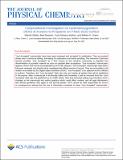Computational Investigation on Hydrodeoxygenation (HDO) of Acetone to Propylene on α-MoO 3 (010) Surface
Author(s)
Shetty, Manish; Buesser, Beat; Román-Leshkov, Yuriy; Green, William H
DownloadAccepted version (1.612Mb)
Terms of use
Metadata
Show full item recordAbstract
© 2017 American Chemical Society. Density functional theory (DFT) calculations were performed on the multistep hydrodeoxygenation (HDO) of acetone (CH3COCH3) to propylene (CH3CHCH2) on a molybdenum oxide (α-MoO3) catalyst following an oxygen vacancy-driven pathway. First, a perfect O-terminated α-MoO3 (010) surface based on a 4 x 2 x 4 supercell is reduced by molecular hydrogen (H2) to generate a terminal oxygen (Ot) defect site. This process occurs via a dissociative chemisorption of H2 on adjacent surface oxygen atoms, followed by an H transfer to form a water molecule (H2O). Next, adsorption of CH3COCH3 on the oxygen-deficient Mo site forms an O-Mo bond and then the chemisorbed CH3COCH3 forms CH3COCH2 by transfer of an H atom to an adjacent Ot site. The surface bound hydroxyl (OH) then transfers the H atom to the immobilized O atom to form surface-bound enol, CH3CHOCH2. The next step releases CH3CHCH2 into the gas phase, while simultaneously oxidizes the surface back to a perfect O-terminated α-MoO3 (010) surface. The adsorption of H2, and the formation of a terminal oxygen (Ot) vacancy, moves the conduction band minimum (CBM) from 1.2 eV to 0 and 0.3 eV, respectively. Climbing image-nudged elastic band (CI-NEB) calculations using a Perdew-Burke-Ernzerhof (PBE) functional in combination with double-ζ valence (DZV) basis sets indicate that the dissociative adsorption of H2 is the rate-limiting step for the catalytic cycle with a barrier of 1.70 eV. Furthermore, the lower barrier for surface-mediated H transfer from primary-to-secondary carbon atom (0.63 eV) compared to that of a concerted direct H transfer to the secondary C atom with simultaneous desorption (2.02 eV) emphasizes the key role played by the surface in H transfer for effective deoxygenation. (Chemical Equation Presented).
Date issued
2017Department
Massachusetts Institute of Technology. Department of Chemical EngineeringJournal
Journal of Physical Chemistry C
Publisher
American Chemical Society (ACS)